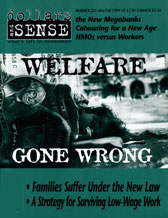Nobel Prize Winner Tweaks Free Marketeers
This article is from the January/February 1999 issue of Dollars and Sense: The Magazine of Economic Justice available at http://www.dollarsandsense.org
This article is from the January/February 1999 issue of Dollars & Sense magazine.

Last October, Amartya Sen, a leading authority on hunger and an unrelenting advocate for the most deprived, won the rare accolade of the Nobel Prize for Economics. Still rarer was his "honor" of being denounced the day after winning by the free-marketeers on the op-ed page of The Wall Street Journal. Journal editorialist Robert L. Pollock accused Sen of having "done little but give voice to the muddleheaded views of ... establishment leftists." Sen is in fact one of the most wide-ranging and questioning economists in the field, whose thoughts are as likely to turn to philosophical investigations of equality as to the measurement of economic well-being.
Born in Bengal, India, in 1933, Sen witnessed the Bengal famine of 1943 in his youth. This experience not only shaped his urgent concern with hunger, but also his "entitlement" approach to the study of famine. This approach starts with the insight that having food available in a country or region does not mean everyone living there is "entitled" to it. In market economies, people are entitled to food according to their ability to produce it for themselves or to pay or swap for it.
If some group loses its entitlement to food, whether there is a decline in the available supply or not, a famine can occur. This may seem obvious, yet before—and after—Sen, famine studies have remained fixated on the drop in food available instead of whether specific social groups are entitled to it. Sen's analysis illuminates the causes not only of the Bengal famine—in which the booming wartime economy priced rural workers, with their low, stagnant incomes, out of the food market—but also of the Irish famine of 1848 and sub-Saharan famines of the 1980s, when food was exported from famine areas to areas where it could fetch a higher price.
Sen's analysis points to relief measures different from the typical "get food to the famine areas" approach. After all, there may be enough food present. Rather, for Sen, the issue is to restore the starving groups' entitlement to food. Cash relief or public works programs, therefore, may be the most effective responses to the danger of famine. Such policies can kick the market into reverse, causing the private food trade to bring food to those in danger, rather than take it away.
It is typical of Sen's work that he acknowledges the positive role that both state action and private markets can play in averting famine, and warns against one-sided ideological prescriptions (whether "indiscriminate liberalism" or "paralysing control") that can hurt famine victims further.
Sen also reveals how distinctions among poor people mark some as vulnerable during famines. While he credits Marx for understanding the economic insecurity of wage workers in general, famine, he says, often strikes subgroups of caste or gender. The same principle holds within families. Looking at family income or resources alone can obscure the deprivation of some household members compared to others. In Hunger and Public Action, Sen (with Jean Dreze) notes that in the early stages of famine, young children are usually protected, the elderly are frequently neglected, and adult men are usually prioritized over adult women.
Even during normal, nonfamine, times in much of the world, women and girls suffer much higher death rates than boys and men, despite the fact that, physiologically, females are hardier than males. Females should have lower rates of death given similar access to food and medical care.
In Europe, North America, and to a lesser extent sub-Saharan Africa, the female-to-male ratio is about what you'd expect, with more women than men. China and Southern Asia are another story, say Sen and Dreze. To have a ratio in China similar to that in sub-Saharan Africa, one would have to add 44 million women. That is, there are 44 million "missing women" due to the relative deprivation (and resulting higher rates of death) of women and especially girls compared to men and boys. In India, the "missing women" number about 37 million. Worldwide, the number exceeds 100 million.
Sen argues that there are fewer missing females where women enjoy independence and greater control of resources such as land, or better access to outside employment. He leaves open the question of whether families make "hard-headed investment calculations" favoring boys over girls to take advantage of boys' higher future earning potential. His attitude is, however, markedly different from that of free-market economists who complacently accept the circumstances under which these sorts of "rationally maximizing" calculations are made.
Instead, Sen emphasizes that no famine has ever raged in a country with an oppositional press and functioning electoral system, since hell-raising by newspapers and oppositional political groups at the first signs of starvation forces governments into action. While it's not enough to end all hunger or gender inequity, Sen, with Dreze, finds hope in civic action: "Ultimately," they write, "public action will be determined by what the public is ready to do, what sacrifices it is ready to make, what things it is determined to demand, and what it refuses to tolerate."
